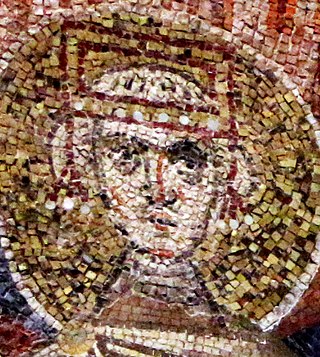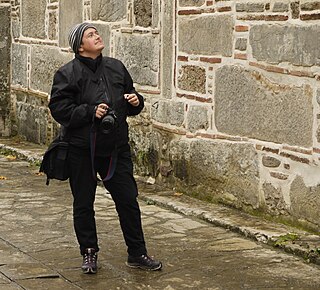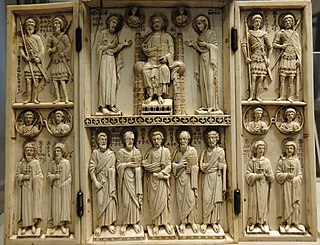
Dumbarton Oaks, formally the Dumbarton Oaks Research Library and Collection, is a historic estate in the Georgetown neighborhood of Washington, D.C. It was the residence and gardens of wealthy U.S. diplomat Robert Woods Bliss and his wife Mildred Barnes Bliss. The estate was founded by the Bliss couple, who gave the home and gardens to Harvard University in 1940. In 1944, it was the site of the Dumbarton Oaks Conference to plan for the post-WWII United Nations. The part of the landscaped portion of the estate that was designed as an enhanced "natural" area, was given to the National Park Service and is now Dumbarton Oaks Park.

Ernst KitzingerFBA was a German-American historian of late antique, early medieval, and Byzantine art.

Byzantine studies is an interdisciplinary branch of the humanities that addresses the history, culture, demography, dress, religion/theology, art, literature/epigraphy, music, science, economy, coinage and politics of the Eastern Roman Empire. The discipline's founder in Germany is considered to be the philologist Hieronymus Wolf (1516–1580), a Renaissance Humanist. He gave the name "Byzantine" to the Eastern Roman Empire that continued after the Western Roman Empire collapsed in 476 AD. About 100 years after the final conquest of Constantinople by the Ottomans, Wolf began to collect, edit, and translate the writings of Byzantine philosophers. Other 16th-century humanists introduced Byzantine studies to Holland and Italy. The subject may also be called Byzantinology or Byzantology, although these terms are usually found in English translations of original non-English sources. A scholar of Byzantine studies is called a Byzantinist.

Sirarpie Der Nersessian was an Armenian art historian, who specialized in Armenian and Byzantine studies. Der Nersessian was a renowned academic and a pioneer in Armenian art history. She taught at several institutions in the United States, including Wellesley College in Massachusetts and as Henri Focillon Professor of Art and Archaeology at Harvard University. She was a senior fellow at Dumbarton Oaks, its deputy director from 1954–55 and 1961–62, and a member of its Board of Scholars. Der Nersessian was also a member of several international institutions such as the British Academy (1975), the Académie des Inscriptions et Belles-Lettres (1978), and the Armenian Academy of Sciences (1966).

Speros Vryonis Jr. was an American historian of Greek descent and a specialist in Byzantine, Balkan, and Greek history.

Robert Woods Bliss was an American diplomat, art collector, philanthropist, and one of the co-founders of the Dumbarton Oaks Research Library and Collection in Washington, D.C.

The Monza ampullae form the largest collection of a specific type of Early Medieval pilgrimage ampullae or small flasks designed to hold holy oil from pilgrimage sites in the Holy Land related to the life of Jesus. They were made in Palestine, probably in the fifth to early seventh centuries, and have been in the Treasury of Monza Cathedral north of Milan in Italy since they were donated by Theodelinda, queen of the Lombards,. Since the great majority of surviving examples of such flasks are those in the Monza group, the term may be used to cover this type of object in general.

Tiberius was Byzantine co-emperor from 659 to 681. He was the son of Constans II and Fausta, who was elevated in 659, before his father departed for Italy. After the death of Constans, Tiberius' brother Constantine IV, ascended the throne as senior emperor. Constantine attempted to have both Tiberius and Heraclius removed as co-emperors, which sparked a popular revolt, in 681. Constantine ended the revolt by promising to accede to the demands of the rebels, sending them home, but bringing their leaders into Constantinople. Once there, Constantine had them executed, then imprisoned Tiberius and Heraclius and had them mutilated, after which point they disappear from history.

Robin Sinclair Cormack, FSA is a British classicist and art historian, specialising in Byzantine art. He was Professor in the History of Art, Courtauld Institute of Art, University of London, 1991–2004.

Liz James is a British art historian who studies the art of the Byzantine Empire. She is Professor of the History of Art at the University of Sussex.

The Church of Hosios David is a late 5th-century church in Thessaloniki, Greece. During Byzantine times, it functioned as the katholikon of the Latomos Monastery, and was adorned with rich mosaic and fresco decoration, which was renewed in the 12th–14th centuries. The church is dedicated to David the Dendrite. Many surviving elements of the Byzantine decoration are of high artistic quality, especially the 5th-century apse mosaic the Icon of Christ of Latomos. Under Ottoman rule, the building was converted into a mosque, until it was reconsecrated as a Greek Orthodox church in 1921, thus receiving its present name. In 1988, this monument was included among the Paleochristian and Byzantine monuments of Thessaloniki on the list of World Heritage Sites by UNESCO.

The Romanos Ivory is a carved ivory relief panel from the Byzantine empire measuring 24.6 cm by 15.5 cm and 1.2 cm thick. The panel is currently in the Cabinet des Médailles of Paris. Inscriptions name the figures of the emperor Romanos and his wife Eudokia, who are being blessed by Christ. However, there were two imperial couples by these names and scholars have yet to agree which is shown. It was first believed to represent Romanos IV and therefore dated between 1068 and 1071. Discoveries of other carved relief works in the 20th century led researchers to think that it represents the earlier Romanos II, changing the date of creation to somewhere between 945 and 949.

Thalia Gouma-Peterson (1933-2001) was Professor Emerita of Art History and museum curator at the College of Wooster in Ohio. Born in Athens, Greece she came to the U.S. as a Fulbright student in 1952.
Leslie Brubaker is an expert in Byzantine illustrated manuscripts. She was appointed Professor of Byzantine Art at the University of Birmingham in 2005, and is now Professor Emerita. Her research interests includes female patronage, icons and the cult of the Virgin Mary. She was formerly the head of Postgraduate Studies in the College of Arts and Law, University of Birmingham. Professor Brubaker is the Chair of the Society for the Promotion of Byzantine Studies. Her work is widely stocked in libraries around the world.

The Trier Adventus Ivory or the Translation of Relics Ivory is an artwork in the Trier Cathedral Treasury in Trier, Germany. The 4th-century relief is a piece of ivory carving from the Byzantine Empire. It was acquired by the Cathedral of Trier in 1844. The work is considered to be an "enigma of Early Byzantine art" and scholars have debated over the ivory's date of manufacture, its original location, and who is depicted. The panel is relatively intact aside from minimal damage to the top right and bottom left corners and some figures having lost their heads.
Carroll F. Wales was an art restorer and conservator of paintings, icons, frescoes, and murals. He specialized in the conservation of early Christian Byzantine art and worked on restoration projects in the Middle East, Europe and the United States. A fine arts major at Harvard College, he received an art conservation degree from the Fogg Art Museum. Wales graduated in 1949 and went on to restore important mosaics and frescoes at prominent museums and religious sites around the world. In addition to these projects, he became co-proprietor with Constantine Tsaousis of Oliver Brothers, an art restoration firm in Boston, Massachusetts.

The situation of women in the Byzantine Empire is a subject of scientific research that encompasses all available information about women, their environments, their networks, their legal status, etc., in the Byzantine Empire.
Henry P. Maguire is an English art historian, specialising in Byzantine art, and Professor Emeritus at Johns Hopkins Krieger School of Arts and Sciences in the History of Art Department. Between 1991-1996, he was Director of Byzantine Studies at Dumbarton Oaks, a research institute of Harvard University.
Alice-Mary Talbot is an American Byzantinist. She is director of Byzantine studies emerita, Dumbarton Oaks Research Library and Collection.
Annabel Jane Wharton is an American art historian with wide-ranging interests from Late Ancient & Byzantine art and culture through to modern architecture and its effect on ancient landscapes. She is currently William B. Hamilton Distinguished Professor of Art History at Duke University, North Carolina and has been working on a project regarding the use of new technologies for visualising historical materials.















